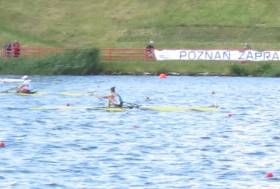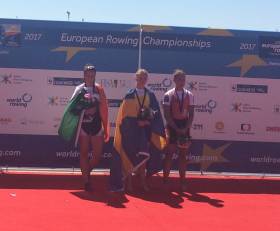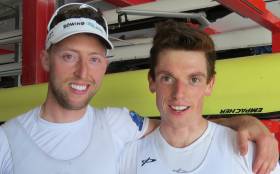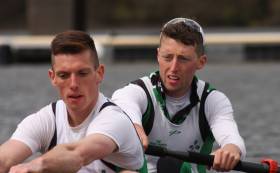Displaying items by tag: O'Driscoll
Brilliant Gold Medal for O'Driscoll and O'Donovan at World Rowing
#Rowing: Ireland’s lightweight pair of Mark O’Donovan and Shane O’Driscoll took a brilliant gold medal at the World Rowing Championships in Sarasota-Bradenton in Florida. They got a tough challenge from Italy and Brazil, but O’Donovan and O’Driscoll produced a stunning row, with a stroke rate of well into the 40s right through the race. They took over the lead at 750 metres and never gave it up, despite concerted challenges by, first, Brazil and then Italy, who took second, with the South Americans taking bronze.
Stars Come Out for Huge Irish Rowing Championships
#Rowing: A bumper weekend of racing is in store in Cork as the 2017 Irish Rowing Championships take place at the National Rowing Centre from Friday, July 14th to Sunday, July 16th. The event will showcase some of the best rowing Ireland has to offer with 1049 crews competing in 264 races.
The National Rowing Centre will welcome 60 clubs, including Waterville and Flesk Valley, who will compete at the Championships for the first time, as well as a re-formed Newry Rowing Club.
High Performance athletes including Gary and Paul O’Donovan, Sanita Puspure and Claire Lambe will be among those competing for the much coveted “Pots”, as well as European Champions Shane O’Driscoll and Mark O’Donovan, and European Silver medallist Denise Walsh.
Three superb days of racing were enjoyed at last year’s Championships, which came to a spectacular end with the men’s senior eights being fought right to the line. Commercial Rowing Club came away with the “Big Pot” in the end after a thrilling race, which saw them finishing less than a second ahead of rivals UCD.
Skibbereen, in combination with UCC, won the women’s senior eight. That win took Skibbereen’s overall tally for the Championships to 13 – they now have 163 titles in total, 11 clear of nearest rivals, Neptune (152).
Dukarska Chosen in Ireland Team for Final World Cup
#Rowing: Monika Dukarska has been chosen to represent Ireland at the third World Cup Regatta in Lucerne early next month. The Killorglin woman finished ninth (third in the B Final) on her first foray as a single sculler at a World Cup event, in Poznan in Poland last weekend. She joins Sanita Puspure, who won the B Final in Poland. The Ireland lightweight pair of Shane O’Driscoll and Mark O’Donovan, who have taken gold in the previous two World Cups and in the European Championships will hope to continue their run. The lightweight double of Paul and Gary O’Donovan were silver medallists at the Europeans and in the World Cup in Poznan.
#Rowing: Ireland made a brilliant start to the final day of the European Rowing Championships.
Mark O’Donovan and Shane O’Driscoll dominated the men’s lightweight pair to take gold and, immediately afterwards, Denise Walsh took a gutsy silver medal in the lightweight single sculls.
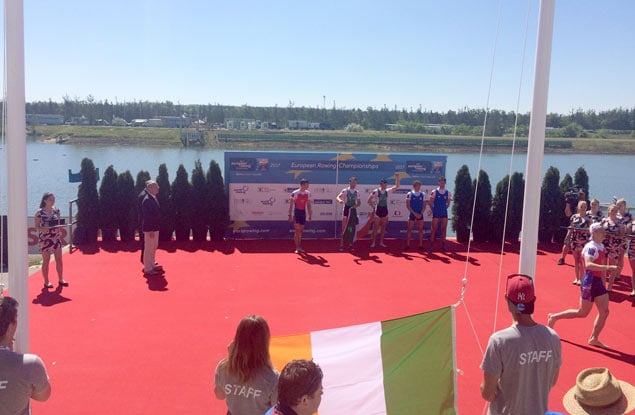 Mark O'Donovan and Shane O'Driscoll medal ceremony
Mark O'Donovan and Shane O'Driscoll medal ceremony
European Rowing Championships, Day Three (Selected Results; Irish interest)
Men
Lightweight Pair – A Final:
1 Ireland (M O’Donovan, S O’Driscoll) 6:32.34, 2 Russia 6:34.74, 3 Italy 6:34.89; 4 Britain (J Cassells, S Scrimgeour) 6:39.75.
Women
Lightweight Single Sculls – A Final: 1 Sweden (E Fred) 7:36.24, 2 Ireland (D Walsh) 7:38.00, 3 Switzerland (P Merz) 7:39.94.
O'Driscoll and O'Donovan Give Classy Display
#Rowing: Mark O’Donovan and Shane O’Driscoll took advantage of the good conditions on the beautiful course to win their exhibition race in the men’s lightweight pair at the European Rowing Championships in Racice. The race counts in the allocation of lanes in the final, and Britain, represented by Joel Cassells and Sam Scrimgeour, and Ireland shot it out the last time this happened, at the World Cup in Belgrade. However, this time Ireland were in command from halfway, tested only by Italy, who finished second.
European Championships, Racice, Czech Republic, Day One (Selected Results; Irish interest)
Men
Lightweight Pair – Exhibition (Race for Lanes): 1 Ireland (M O’Donovan, S O’Driscoll) 6:57.77, 2 Italy 6:59.82, 3 Russia 7:01.75, 4 Britain (J Cassells, S Scrimgeour) 7:03.39.
Lightweight Double Sculls – Heats (Winner to A/B Semi-Finals; rest to Repechages) – Heat One: 1 France (P Houin, J Azou) 6:26.97. Heat Two: Germany (L Schaefer, J Osborne) 6:37.53.
Heat Three: 1 Poland 6:25.93, 2 Ireland (G O’Donovan, P O’Donovan) 6:32.15, 3 Russia 6:36.38, 4 Switzerland 6:40.60, 5 Austria. Heat Four: 1 Italy 6:30.77.
Women
Lightweight Single Sculls – Heat One (First Three to Semi-Finals; rest to Repechage): 1 Ireland (D Walsh) 7:44.85, 2 Denmark (A Runge Holmegaard) 7:49.49, 3 Poland (J Dorociak) 7:49.90; 4 Czech Republic 8:05.07, 5 Portugal 8:08.19. Heat Two: 1 Switzerland 7:42.510. Heat Three: 1 Sweden 7:39.52.
Gold for O'Driscoll and O'Donovan at World Cup
#Rowing: Ireland won the first gold medal of the World Cup Regatta in Belgrade this morning through an outstanding performance by Mark O’Donovan and Shane O’Driscoll in the lightweight pair. They took on and beat the Britain crew of Joel Cassells and Sam Scrimgeour – who in a tight finish could not hold second and finished third behind Russia.
O'Donovan told the official worldrowing site that they felt good during the race and gave credit to Dominic Casey, who is now the Ireland head coach. "Going forward we are going to a training camp in Varese and looking to implement new training and technique before Europeans.”
Cassells said: “We knew it was going to be a challenge. It was a pretty hard finish. The plan is to learn, the future is to get to the European Championships and retain the title.”
World Cup Regatta, Belgrade (Selected results; Irish interest)
Men
Lightweight Pair – Final: 1 Ireland (M O’Donovan, S O’Driscoll) 6:46.65, 2 Russia 6:47.67, 3 Britain (J Cassells, S Scrimgeour) 6:48.40.
Top Rowers Pull Together for Pieta House
#Rowing: A group of Ireland’s top rowers are hosting a special charity event this Sunday. The Run to Row at the National Rowing Centre in Farran Woods park in Cork is being held to raise funds for Pieta House, the charity which deals with people have suicidal ideation or who self-harm. There are prizes for families and for individuals who take part. Irish internationals Shane O’Driscoll, Mark O’Donovan and Sanita Puspure are behind the drive. “It’s alarming to hear of young people taking their own lives,” Puspure said. “All the funds from Sunday will go to Pieta House. There is a real need there.”
O'Driscoll and O'Donovan Denied in World Rowing Final
#Rowing: Mark O'Donovan and Shane O'Driscoll finished fourth in the A Final of the lightweight men's pair at the World Rowing Championships in Rotterdam today. France won impressively, under pressure from Denmark in the closing stages, with the defending champions, Britain, having to settle for the bronze medal. O'Donovan and O'Driscoll finished out well, pushing hard to pressure Britain, but they held firm.
Holly Nixon from Enniskillen was part of the Britain's women's four which won gold.
World Rowing Championships, Rotterdam (Irish interest; selected results)
Men
Lightweight Pair - A Final: 1 France 7:14.18, 2 Denmark 7:15.30, 3 Britain (J Cassells, S Scrimgeour) 7:16.49; 4 Ireland (M O'Donovan, S O'Driscoll) 7:24.6, 5 China 7:32.48, 6 United States 7:36.91.
Lightweight Single Sculls - A Final: 1 Ireland (P O'Donovan) 7:32.84, 2 Hungary (P Galambos) 7:36.95, 3 Slovakia (L Babac) 7:38.89; 4 Slovenia (R Hrvat) 7:41.07, 5 Germany (K Steinhuebel) 7:48.66, 6 Serbia (M Stanojevic) 7:49.03.
Women
Four - A Final: 1 Britain (3 H Nixon) 7:16.28.
O'Driscoll and O'Donovan in World Rowing Semi-Finals
#Rowing: Shane O’Driscoll and Mark O’Donovan qualified for the A/B Semi-Finals of the World Rowing Championships today. Two boats qualified from the heat of the lightweight pair, and the Ireland crew chased the world champions, Britain, down the course. Russia eventually finished third, but by then the Ireland crew had nailed the crucial second place.
World Rowing Championships, Rotterdam (Selected Results; Irish interest)
Men
Lightweight Pair - Heat Two (First Two to A/B Semi-Finals; rest to Repechages): 1 Britain (J Cassells, S Scrimgeour) 6:37.05, 2 Ireland (M O’Donovan, S O’Driscoll) 6:38.84; 3 Russia 6:44.40, 4 Spain 6:45.08, 5 China 6:59.44.
Lightweight Single Sculls - Heat Three (Four to Quarter-Finals; rest to Repechages): 1 Ireland (P O’Donovan) 7:11.73, 2 Japan 7:16.87, 3 Serbia 7:19.70, 4 China 7:23.04.
Under-23 Quadruple - Repechage One (Three to A/B Semi-Finals; rest to C Final): 1 Britain 5:54.05, 2 Russia 5:56.18, 3 Ireland (D Buckley, J Casey, P Boomer, S McKeown) 5:57.67.
Paul O'Donovan in Strong World Championship Team
#Rowing: Ireland have picked a strong set of crews for the World Rowing Championships in Rotterdam at the end of August. Olympian Paul O’Donovan will return from Rio de Janeiro to take part in the lightweight single scull (not the under-23 lightweight single), and the senior lightweight pair of Shane O’Driscoll and Mark O’Donovan hope to improve on their seventh placing last year. There will be two Ireland under-23 quadruples, heavyweight and lightweight. There will be more trialling to determine the Ireland women’s lightweight single scull.
The junior women’s and men’s doubles did enough at Cork Regatta to merit selection. Four crews were also picked for the Coupe de la Jeunesse, a European tournament, after Cork Regatta.
Ireland Crews (conditional on training in a prolonged camp, further racing and fulfilling other selection requirements)
Junior, Under-23 and Senior World Championships, August 21st-28th Rotterdam, Netherlands.
Team Manager: Susan Dunlea
Senior: Lightweight Men’s Pair: Shane O’Driscoll (Skibbereen RC), Mark O’Donovan (Skibbereen RC). Coach: Noel Monahan. Lightweight Men’s Single: Paul O’Donovan (UCD BC). Coach: Dominic Casey (Skibbereen RC)
Under-23 Men’s Quadruple: Sam McKeown (Portadown BC), Jack Casey (UCCRC), Patrick Boomer (UL), Dan Buckley (NUIGBC). Coach: James Mangan (Castleconnell BC). Under-23 Lightweight Men’s Quadruple: Stephen O’Connor (UCCRC), Shane O’Connell (UCDBC), Colm Hennessy (Shandon BC), Fintan McCarthy (Skibbereen RC). Coach: Paul Thornton (UCCRC).
Junior Men’s Double Sculls: Ronan Byrne (Shandon BC), Daire Lynch (Clonmel RC). Coach: TBD. Junior Women’s Double: Emily Hegarty, Aoife Casey (Skibbereen RC). Coach: TBD
Coupe de la Jeunesse Crews, July 29-31, Poznan, Poland. Team Manager: Michelle Carpenter
Junior Men’s Four: Aaron Johnston (Portora BC), Samuel Armstrong (Portora BC), Ross Corrigan (Portora BC), Patrick Kennelly (Presentation BC). Coach: Fran Keane (Presentation BC). Junior Men’s Quadruple: Stephen O’Sullivan (Shandon BC), Barry Connolly (Cork BC), Niall Beggan (Commercial RC), Barry O’Flynn (Cork BC). Coach: TBD
Junior Women’s Pair: Amy Mason (Cork BC), Tara Hanlon (Cork BC). Coach: Fran Keane (Presentation BC). Junior Women’s Quadruple: Fiona Chestnutt (Bann RC), Hannah Scott (Bann RC), Lucy Taylor (Belfast RC), Margaret Cremin (Lee RC). Coach: TBD





























